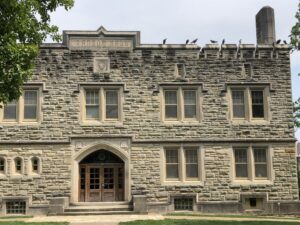Kenyon College ‘blows open the doors’
Kenyon College in rural Gambier, Ohio, has been known as the Writer’s College for its connection to the literary magazine Kenyon Review, novelist John Green (The Fault in Our Stars), and poet Robert Lowell. A solid liberal arts college, ranked 28th in national LACs by US News & World Report, it’s a haven for those who love learning.

I attended a student panel on August 11, 2021—admissions felt the audience would get a better look at Kenyon through students’ eyes. The presenter introduced the panel saying, “Our job is to blow the doors open on what you think you love.” The four panelists told of how they each came in thinking their path was set, but found their passion in unexpected places, partly through the four areas of diversification requirements.
To cultivate depth along with breadth, for the diversification requirement students must take two courses in one area in each of four “buckets”: fine arts, humanities, natural sciences, and social sciences. For example, you might take psychology for your first course in the natural science bucket, and developmental psychology to deepen your knowledge in that area. Majors must be declared before the beginning of junior year. Kenyon has added some interesting interdisciplinary majors, too, like biochemistry, environmental studies, international studies, and neuroscience.
Kenyon supports you with a safety net as you try new things and step out of your comfort zone. With fewer than 1,800 students, Kenyon feels like a community of supportive peers. One student was thrilled to find a full house in the audience for her a capella group; she’d been used to seeing only a handful of listeners before arriving in Gambier.
Kenyon vibrates with artistic sensibility. Surprising sculptures pop up in fields and on rooftops. My favorite sculpture is a series of crows atop the admissions building–a pun on the building’s namesake, Russell Crowe Ransom. Theater is big: Allison Janney and (sigh, grandmothers) Paul Newman are Kenyon alum.
But it’s not all art and humanities. One panelist said he had disliked AP Physics in high school, but that when he became intrigued with a laser machine on campus, a physics professor offered to teach him how to use it and to involve him in research. That panelist, now a physics major, said that research and classwork are integrated.
Kenyon offers writers and readers multiple vehicles for multiple genres. The Kenyon Review is the number one literary magazine in the U.S., taking submissions from professors across the country, but there’s also a STEM-focused magazine called Lyceum, a humor blog, a school newspaper, and a satirical newspaper.
All classes emphasize communication. Revolving around discussion and collaboration classes are kept small, with 15 the average class size. Apparently an intro to psychology course once had 52 enrolled, and it was a scandal!
Community service is woven into the fabric of Kenyon, located in the midst of extreme rural poverty. Billy Shakes, a Shakespearean theater group, performs and educates at the local elementary school. Kenyon has a lunch buddies program to mentor local kids, tutoring, middle school sex education, and an affiliation with a women’s shelter. Their philosophy is “listen to understand, not to reply.”
Kenyon is also committed to diversity, equity, and inclusion, with 10 percent of the student activity fee going to DEI efforts. The Kenyon Educational Experience Program (KEEP) funds four years at Kenyon, including room and board, beginning with five and a half weeks of immersion for freshmen before classes begin in the fall. KEEP provides four years of mentoring for these students, who must be either first-generation or students of color.
If you apply to Kenyon, multiple eyes will review your application. Of primary importance is your transcript in the context of your high school. Did you take advantage of the opportunities you had there? Did you challenge yourself? Secondly, they read carefully the teacher recommendations. Third, they want to see quality, not quantity of activities, depth in fewer activities rather than superficial involvement in many activities. You’ll submit only one essay; there are no supplemental essays as part of the application.
Don’t let the sticker price keep you away. Kenyon meets 100 percent of demonstrated need. Use their net price calculator to estimate what you will pay, or call the financial aid office. You’ll find friendly people on the line.